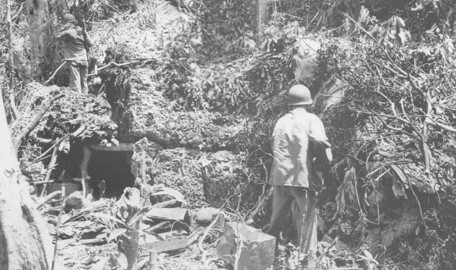On February 9, 1943, the United States declared victory against Japan in the seven-month World War II campaign for Guadalcanal and nearby islands in the southwest Pacific. The victory was a major turning point in the Pacific War.
The Guadalcanal Campaign
In December 1941, Japan launched a surprise attack on Pearl Harbor that drew the United States into World War II. American forces were put on the defensive as they hastily mobilized for war, but important victories at Coral Sea and Midway in May and June 1942, respectively, allowed them to begin going on the offensive.
United States leadership decided to target islands in the Solomon archipelago, most notably Guadalcanal, that had been seized by Japan following its loss at Coral Sea. Japan’s position in the Solomons threatened supply lines and lines of communication from the United States to Australia and New Zealand and put those Allied islands at risk of an invasion.
On August 7, 1942, Allied forces launched amphibious invasions of Guadalcanal, Tulagi, Florida, Gavutu and Tanambogo. They defeated outnumbered Japanese forces on the smaller islands and capture them within days. At Guadalcanal, Japanese forces retreated to the western part of the island, allowing the islands to seize a newly constructed airfield on Guadalcanal, which became known as Henderson Airfield.
Over the next several months, Japan launched air, ground and sea attacks on Allied forces in an attempt to reclaim the islands. In November, Japan decided to launch a large-scale invasion of Guadalcanal, igniting the decisive battle of the Guadalcanal campaign, the Naval Battle of Guadalcanal.
United States intelligence learned of Japan’s plans, allowing American forces to be dispatched to Guadalcanal to defend the island. Both sides suffered heavy losses during the battle, but the United States succeeded in preventing Japan from reaching Guadalcanal and threatening the airfield.
Sources in this Story
- U.S. Army Center of Military History: Guadalcanal
- The War Times Journal: The Guadalcanal Campaign
- HistoryNet: Second Naval Battle of Guadalcanal: Turning Point in the Pacific War
The Naval Battle of Guadalcanal was Japan’s last attempt to recapture the islands. With the remaining Japanese troops on the island suffering from disease and malnutrition, Japan decided to evacuate the more than 10,000 men remaining on Guadalcanal.
The Guadalcanal defeat put Japan on the defensive for the first time and they would remain on the defensive for the remainder of the war. The United States launched a campaign of “island hopping” toward Japan and eventually reached the Japanese Home Islands before dropping two atomic bombs that forced Japan to surrender.
Historical Context: Pacific War
The findingDulcinea Web Guide to World War II features links to the best sites for learning about the Pacific War.











